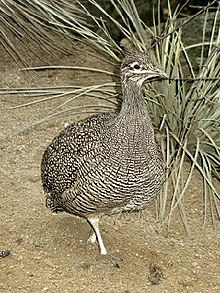Eudromia
| Eudromia | |
|---|---|

| |
| Elegant crested tinamou (Eudromia elegans) | |
| Scientific classification | |
| Kingdom: | Animalia |
| Phylum: | Chordata |
| Class: | Aves |
| Infraclass: | Palaeognathae |
| Order: | Tinamiformes |
| Family: | Tinamidae |
| Subfamily: | Nothurinae |
| Genus: | Eudromia I. Geoffroy Saint-Hilaire, 1832 |
| Species | |
|
Eudromia elegans | |
Eudromia is a genus of birds in the tinamou family. This genus comprises two crested members of this South American family.
Etymology[]
Eudromia comes from two Greek words, eu meaning well or nicely, and dromos meaning a running escape. These definitions together mean, nice running escape, which refers to their habit of escaping predators by running.[1]
Taxonomy[]
Tinamous are paleognaths related to the flightless ratites. They are probably close in appearance to the flying ancestors of the ratites. Unlike other ratites, tinamous can fly, although in general, they are not strong fliers.[2]
This genus has a mere 2 species, but the elegant crested tinamou has diversified into a considerable number of subspecies:
- †Eudromia sp. (Late Miocene of La Pampa Province, Argentina)
- † Tambussi & Tonni 1985 [ Dabbene & Lillo 1913 non Rovereto 1914; (Dabbene & Lillo 1913)] (Late Pliocene of Buenos Aires Province, Argentina)[5]
- † (Rovereto 1914) [ Rovereto 1914 non Dabbene & Lillo 1913] (Pliocene of Argentina)
- The quebracho crested tinamou, Eudromia formosa, located in Paraguay and northern Argentina[6]
- The elegant crested tinamou, Eudromia elegans, located in Argentina and southern Chile[6]
- Eudromia elegans elegans located in central Argentina[6]
- Eudromia elegans intermedia located in northwestern Argentina[6]
- Eudromia elegans magnistriata located in northwestern Argentina[6]
- Eudromia elegans riojana located in northwestern Argentina[6]
- Eudromia elegans albida located in western Argentina[6]
- Eudromia elegans multiguttata located in east central Argentina[6]
- Eudromia elegans devia located in southwestern Argentina[6]
- Eudromia elegans patagonica located in southern Argentina and southern Chile[6]
- Eudromia elegans numida located in central Argentina[6]
- Eudromia elegans wetmorei located in western Argentina[6]
Footnotes[]
- ^ Gotch, A. F. (1995)
- ^ Davies, S. J. J. F. (2003)
- ^ Mikko's Phylogeny Archive [1] Haaramo, Mikko (2007). "Tinamiformes - tinamous". Retrieved 30 December 2015.
- ^ Paleofile.com (net, info) "Archived copy". Archived from the original on 2016-01-11. Retrieved 2015-12-30.CS1 maint: archived copy as title (link). "Taxonomic lists- Aves". Archived from the original on 11 January 2016. Retrieved 30 December 2015.
- ^ Description de deux nouvelles espèces d'oiseaux de la Républic Argentine: un perroquet du genre Cyanolyseus et un tinamou du genre Calopezus. R Dabbene and M Lillo, 1913
- ^ a b c d e f g h i j k l m n Clements, J. (2007)
References[]
- Brands, Sheila (Aug 14, 2008). "Systema Naturae 2000 / Classification, Genus Eudromia". Project: The Taxonomicon. Retrieved 12 Feb 2009.
- Clements, James (2007). The Clements Checklist of the Birds of the World (6 ed.). Ithaca, NY: Cornell University Press. ISBN 978-0-8014-4501-9.
- Davies, S.J.J.F. (2003). "Tinamous". In Hutchins, Michael (ed.). Grzimek's Animal Life Encyclopedia. 8 Birds I Tinamous and Ratites to Hoatzins (2 ed.). Farmington Hills, MI: Gale Group. pp. 57–59. ISBN 0-7876-5784-0.
- Gotch, A. F. (1995) [1979]. "Tinamous". Latin Names Explained. A Guide to the Scientific Classifications of Reptiles, Birds & Mammals. New York, NY: Facts on File. p. 183. ISBN 0-8160-3377-3.
External links[]
| Wikimedia Commons has media related to Eudromia. |
- Eudromia
- Bird genera


